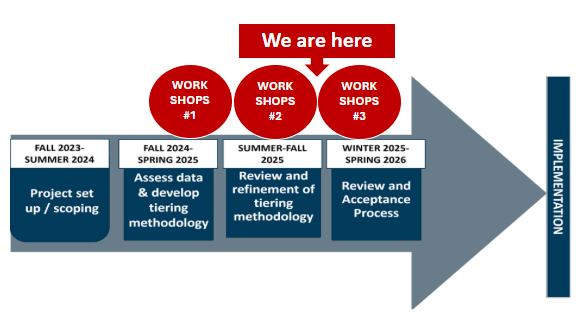Emergency Transportation Routes Phase 2
Regional Emergency Transportation Routes (ETRs) are defined as priority routes targeted during an emergency for rapid damage assessment and debris-clearance. They are used to facilitate life-saving and life-sustaining response activities, including the transport of first responders (e.g., police, fire and emergency medical services), fuel, essential supplies and patients.
PROJECT BACKGROUND
The Regional ETR project was initially identified in Metro’s 2018 Regional Transportation Plan as a necessary step to better integrate transportation with planning for resiliency, recovery, and emergency response.
Phase 2 of the Regional ETR project was identified as a follow on project to ETR Phase 1 work in Metro’s 2023 Regional Transportation Plan.
Funding for the project is provided by the Urban Areas Security Initiative (UASI) grant from the Federal Emergency Management Agency (FEMA), which is managed by the RDPO.
CURRENT WORK - PHASE 2 (2024-2026)
A second phase of the project began in 2024. This phase is developing a methodology to prioritize and tier the updated network of routes.
The project is again co-managed by RDPO and Metro.
PHASE 2 PROJECT TIMELINE AND ENGAGEMENT
Targeted partner engagement will take place through a series of workshops:
Technical workshops to include partners from fire, law enforcement, public works and utilities, transportation planning, and emergency management who have a response role in the immediate aftermath of a natural disaster or emergency event.
Community organization workshops as part of a larger Metro effort to engage community-based organizations across four Metro-led efforts, including RETRs. The purpose of these engagements is to understand the needs and priorities of disaster-vulnerable communities.
PROJECT WORK GROUP
Core planning partners in phase 2 include transportation and emergency management representatives from:
RDPO
Metro
City of Beaverton
City of Gresham
City of Hillsboro
City of Portland
City of Vancouver
Cities of Clackamas County
Clackamas County
Clark County
Columbia County
Multnomah County
Washington County
Oregon Department of Transportation
Washington State Department of Transportation
Port of Portland
TriMet
C-TRAN
Portland State University Transportation Research and Education Center (TREC)
PROJECT MANAGEMENT
Carol Chang, RDPO, carol.chang@portlandoregon.gov
John Mermin, Metro, john.mermin@oregonmetro.gov
CONSULTING TEAM
Fehr & Peers
Thuy Tu Consulting
Haley & Aldrich

